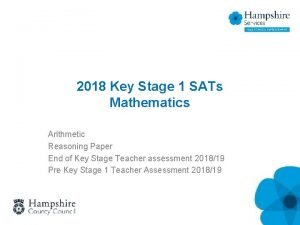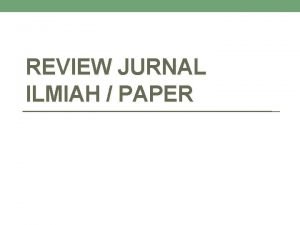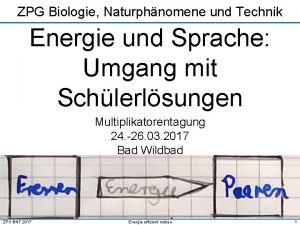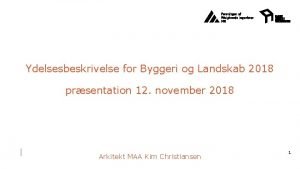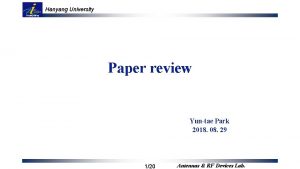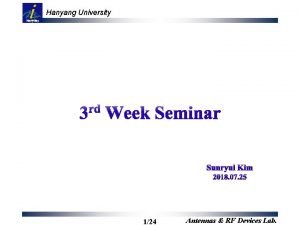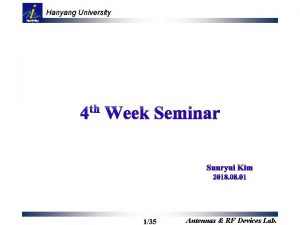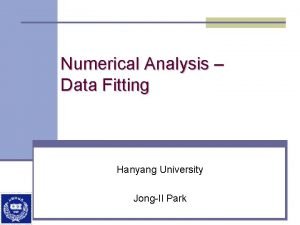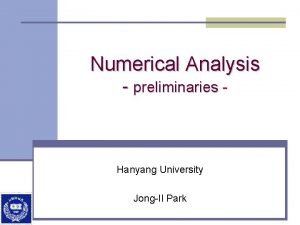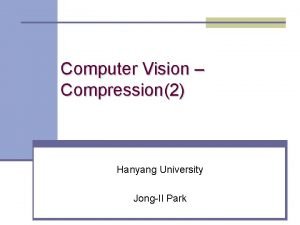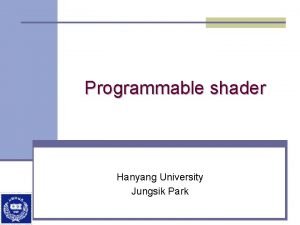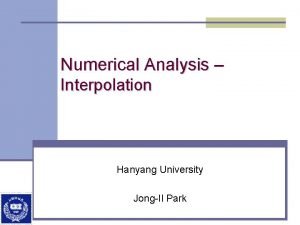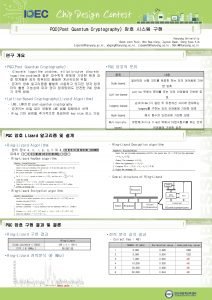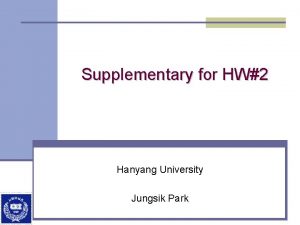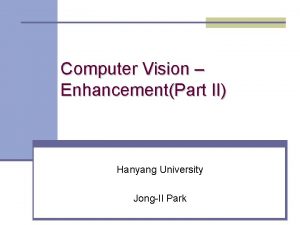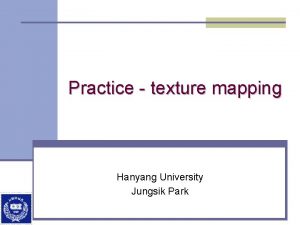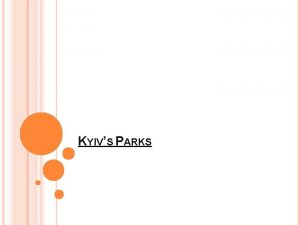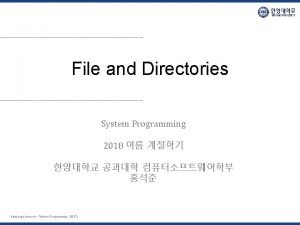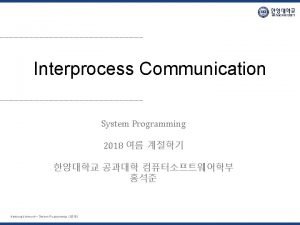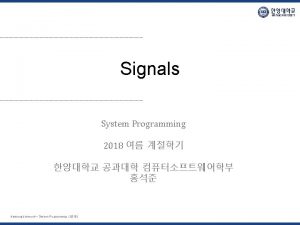Hanyang University Paper review Yuntae Park 2018 07


























- Slides: 26

Hanyang University Paper review Yun-tae Park 2018. 07. 25 1/26 Antennas & RF Devices Lab.

Hanyang University Contents l Compact Tapered Slot Antenna Array for 5 G Millimeter-Wave Massive MIMO Systems - IEEE TRANSACTIONS ON ANTENNAS AND PROPAGATION, VOL. 65, NO. 12, DECEMBER 2017 l A Compact Gain-Enhanced Vivaldi Antenna Array With Suppressed Mutual Coupling for 5 G mm. Wave Application - IEEE ANTENNAS AND WIRELESS PROPAGATION LETTERS, VOL. 17, NO. 6, MAY 2018 2/26 Antennas & RF Devices Lab.

Hanyang University Compact Tapered Slot Antenna Array for 5 G Millimeter-Wave Massive MIMO Systems I. Introduction The millimeter-wave communication is regarded as one of the most potential solutions for the exponentially expanding wireless data traffic in the future, due to the wide usable spectrum in the millimeter waveband. However, the radio waves suffer large path-loss and limited scattering in the millimeter waveband. massive multiple-input multiple-output (MIMO) technique & beamforming technique An antenna array with large element spacing will introduce high sidelobes and then cause multiuser interference. the requirement of the antenna element spacing in the beamforming system is around half-wavelength Figure 1. Millimeter-wave communication system model for the multiuser MIMO beamforming. 3/26 Antennas & RF Devices Lab.

Hanyang University Compact Tapered Slot Antenna Array for 5 G Millimeter-Wave Massive MIMO Systems I. Introduction • A broadband millimeter-wave tapered slot antenna (TSA) with low complexity and compact size is proposed. • The TSA is a good candidate for millimeterwave communication systems. - medium gain - wide operation bandwidth • The antenna element is a substrate-integrated waveguide (SIW)-fed metallic TSA with a new type of transition between the SIW and the tapered slot. - SIW feeding structure allows the antenna array to be integrated with other planar circuits easily 4/26 Antennas & RF Devices Lab.

Hanyang University Compact Tapered Slot Antenna Array for 5 G Millimeter-Wave Massive MIMO Systems II. Antenna Design - Antenna Configuration for 5 G mm. Wave Communication • The vertical polarization is used in the proposed 5 G massive MIMO BS, although dual polarization is widely utilized in current lowband BS to achieve better performance by using the polarization diversity. • Given that most of the users and the scatters are spread horizontally, most beams are formed in the horizontal plane (H-plane). arranging the array in the H-plane with half-wavelength element spacing is required, and the H-plane beamwidth should be wider to obtain a large beam scanning angle • The proposed antenna is intended for millimeter-wave digital beamforming (DBF) communication system. - high flexibility & the greatest performance Each antenna element needs to be associated with a complete RF chain and a baseband processing unit (BBU). 5/26 Antennas & RF Devices Lab.

Hanyang University Compact Tapered Slot Antenna Array for 5 G Millimeter-Wave Massive MIMO Systems II. Antenna Design - Antenna Element As shown in Fig. 3, the proposed antenna element consists of an SIW feeding board and two metallic structures. The SIW feeding board is constituted by three parts: a grounded coplanar waveguide (CPWG) to SIW transition, an SIW feeding section, and an SIW to tapered slot vertical transition. Figure 3. Structure diagram of the proposed TSA. Figure 4. Dimensions of the proposed TSA element. 6/26 Antennas & RF Devices Lab.

Hanyang University Compact Tapered Slot Antenna Array for 5 G Millimeter-Wave Massive MIMO Systems II. Antenna Design - Antenna Element The SIW extended with a substrate taper is clamped by the metallic tapered slot at the open-circuit end. A wideband vertical transition between SIW and metallic tapered slot is formed by this structure. Due to the similar field modes of the SIW section and the metallic tapered slot, good matching of impedance and field is achieved over a wide bandwidth. 7/26 Antennas & RF Devices Lab.

Hanyang University Compact Tapered Slot Antenna Array for 5 G Millimeter-Wave Massive MIMO Systems II. Antenna Design - Antenna Element With this width, the antenna has a very good reflection coefficient and a wide H-plane beamwidth. The simulated reflection coefficient is lower than -20 d. B from 24 to 32 GHz. The beamwidth of the H-plane and the E-plane are about 70° and 40°, respectively. Obviously, the polarization of the proposed antenna element is vertical to the substrate. 8/26 Antennas & RF Devices Lab.

Hanyang University Compact Tapered Slot Antenna Array for 5 G Millimeter-Wave Massive MIMO Systems II. Antenna Design - Antenna Array and Digital Beamforming As an array example, a simplified structure of the compact H-plane array with four elements is designed and is demonstrated in Fig. 8. The antenna array with eight or more elements, which are arranged with halfwavelength spacing, can also be realized on one substrate. The antenna array can be connected to the millimeter-wave transceiver circuits by the SIW instead of cables and connecters. Additional benefit of the H-plane array is the wider beam scanning range. Figure 8. Structure of the H-plane antenna array with half-wavelength element spacing. 9/26 Antennas & RF Devices Lab.

Hanyang University Compact Tapered Slot Antenna Array for 5 G Millimeter-Wave Massive MIMO Systems II. Antenna Design - Antenna Array and Digital Beamforming Each antenna element in DBF architecture is connected to a complete RF chain, which includes a millimeter wave transceiver, digital-to-analog converters, analog-to-digital converters, and one BBU. The signal phase on each antenna element is controlled within 0°-360° arbitrarily by using the DBF precoding in the BBU. Figure 9. Transmitter architecture of the developed millimeter-wave DBF system. 10/26 Antennas & RF Devices Lab.

Hanyang University Compact Tapered Slot Antenna Array for 5 G Millimeter-Wave Massive MIMO Systems III. Experimental Results Figure 10. Photograph of the fabricated TSA element. 11/26 Antennas & RF Devices Lab.

Hanyang University Compact Tapered Slot Antenna Array for 5 G Millimeter-Wave Massive MIMO Systems III. Experimental Results - Radiation Performance Figure 12. Measured and simulated reflection coefficients of the antenna element. Figure 13. Measured and simulated gains of the proposed antenna element. The measured gain varies from 8. 2 to 9. 6 d. Bi over the frequency range from 24 to 32 GHz, which is about 0. 6 -1 d. B lower than the simulated result. 12/26 Antennas & RF Devices Lab.

Hanyang University Compact Tapered Slot Antenna Array for 5 G Millimeter-Wave Massive MIMO Systems III. Experimental Results - Radiation Performance 28 GHz 24 GHz Figure 14. Measured and simulated radiation patterns of the proposed antenna element. 32 GHz 13/26 Antennas & RF Devices Lab.

Hanyang University Compact Tapered Slot Antenna Array for 5 G Millimeter-Wave Massive MIMO Systems III. Experimental Results - Radiation Performance The measured results are well matched with the simulated results. The simulated and measured beamwidths of the proposed antenna element are listed in Table II. The H-plane and E-plane beamwidths of the antenna element at 28 GHz are 69° and 42°, respectively. The measured results illustrate good radiation characteristics across a wide frequency band from 24 to 32 GHz. 14/26 Antennas & RF Devices Lab.

Hanyang University Compact Tapered Slot Antenna Array for 5 G Millimeter-Wave Massive MIMO Systems III. Experimental Results - Radiation Performance The antenna array is arranged in horizontal direction to scan the beam in azimuth plane. The DBF precoding configuration for 0°, ± 17. 5°, and ± 35° beam angles are calculated and listed in Table III. The main beam can be scanned from -35° to 35° within 3 d. B gain fluctuation. The sidelobe levels are approximately -9 d. B. 15/26 Antennas & RF Devices Lab.

Hanyang University Compact Tapered Slot Antenna Array for 5 G Millimeter-Wave Massive MIMO Systems IV. Conclusion • A wideband millimeter-wave TSA for 5 G millimeterwave MIMO communication has been presented. • The proposed H-plane array has the advantage of integration with the multichannel transceiver circuits on the same substrate and the element spacing can meet the requirement of half-wavelength. • The vertical spacing has no restriction in the developed 5 G MIMO prototype because each H-plane array has independent data stream. • The proposed antenna has the advantages of low complexity, wideband, good radiation performances, and high integration ability. • The small effective occupied size in the H-plane makes it very suitable for millimeter-wave MIMO beamforming systems and other millimeter-wave phased array applications. 16/26 Antennas & RF Devices Lab.

Hanyang University A Compact Gain-Enhanced Vivaldi Antenna Array With Suppressed Mutual Coupling for 5 G mm. Wave Application The. I. urge to use millimeter-wave (mm. Wave) bands to improve communication quality is a necessary solution for 5 G Introduction wireless communication. In order to overcome high propagation loss occurred within mm. Wave bands, an antenna with wideband, stable radiation characteristics, and high gain is desirable. Vivaldi antenna (easy fabrication & light weight characteristics) While array structures are typically used to achieve the high realized gain, at the same time, there is an unavoidable problem in array design, which is how to solve the contradiction between the sidelobe and the mutual coupling of the elements. High sidelobe - the decrease of antenna radiation performance High coupling - significant degradation on the bandwidth and antenna gain In general, the low sidelobe can only be realized by decreasing the distance between the elements. We need to do the coupling reduction in case of close distance. 17/26 Antennas & RF Devices Lab.

Hanyang University A Compact Gain-Enhanced Vivaldi Antenna Array With Suppressed Mutual Coupling for 5 G mm. Wave Application I. Introduction • A low-complexity, linear-polarization, and compact-size broadband mm. Wave antipodal Vivaldi antenna (AVA) array with a 1 -to-8 wideband power divider feed network is presented. - A planar structure - Good radiation characteristics - The gain of modified AVA array is up to 12. 7 d. B within the frequency range from 24. 6 to 28. 5 GHz, which covers the 24. 75 to 27. 5 GHz band proposed by the MIIT and 27. 5 to 28. 35 GHz band proposed by the FCC for the future 5 G application. 18/26 Antennas & RF Devices Lab.

Hanyang University A Compact Gain-Enhanced Vivaldi Antenna Array With Suppressed Mutual Coupling for 5 G mm. Wave Application II. Antenna Array Design The initial AVA array contains three layers, and eight left and right arms of the AVA array are printed on the top and bottom layer, respectively. The eight left arms are connected with a 1 -to-8 power divider feed network, and the eight right arms are terminated in a ground plane. Figure 1. Configuration of the proposed (a) AVA array. 19/26 Antennas & RF Devices Lab.

Hanyang University A Compact Gain-Enhanced Vivaldi Antenna Array With Suppressed Mutual Coupling for 5 G mm. Wave Application However, each element of. Design the AVA array can be coupled with the adjacent one because the eight right arms are II. Antenna Array terminated in a common ground plane, which degrades the radiation performance of the AVA array. Figure 1. Configuration of the proposed (b) AVA-CR array. 20/26 Antennas & RF Devices Lab.

Hanyang University A Compact Gain-Enhanced Vivaldi Antenna Array With Suppressed Mutual Coupling for 5 G mm. Wave Application The effect of multiple notch structures on mutual coupling reduction is studied by removing the 1 -to-8 power divider. II. Antenna Array Design From the presented results, it is observed that the mutual coupling is reduced in a wide frequency band, and multiple notch structures provide maximal additional 37. 3 d. B enhancement in the isolation between the antenna elements at 27. 4 GHz. Figure 4. Simulated and measured gain comparison for two different antenna array structures. Figure 3. Simulated mutual coupling characteristics comparison for two different antenna array structures. 21/26 Antennas & RF Devices Lab.

Hanyang University A Compact Gain-Enhanced Vivaldi Antenna Array With Suppressed Mutual Coupling for 5 G mm. Wave Application II. Antenna Array Design It can be seen that plane-like waves can be obtained in the whole operating frequency band due to the antenna array. However, the AVA-CR array gets an improved direction than AVA array at the same frequency. In addition, a stronger E-field coupling between the elements of the AVA array compared with the AVA-CR array can be obviously seen from Fig. 5. All these result in the gain of the AVA-CR array being higher than the gain of the AVA array. Figure 5. Simulated E-field distributions: (a) AVA array at 26 GHz, (b) AVA-CR array at 26 GHz, (c) AVA array at 28 GHz, and (d) AVA-CR array at 28 GHz. 22/26 Antennas & RF Devices Lab.

Hanyang University A Compact Gain-Enhanced Vivaldi Antenna Array With Suppressed Mutual Coupling for 5 G mm. Wave Application III. Measured Results and Discussion Figure 6. Fabricated AVA array (left) and AVA-CR array (right) photographs. Figure 4. Simulated and measured gain comparison for two different antenna array structures. 23/26 Antennas & RF Devices Lab.

Hanyang University A Compact Gain-Enhanced Vivaldi Antenna Array With Suppressed Mutual Coupling for 5 G mm. Wave Application To clearly illustrate the multiple notch structures effect on the AVA array and validate the performance of the designed AVA-CR array, the simulated and measured normalized radiation patterns of the AVA array and AVA-CR array in E-plane and H-plane at 26 and 28 GHz are shown in Fig. 7. III. Measured Results and Discussion Figure 7. Simulated and measured normalized radiation patterns comparison for proposed antenna arrays. 24/26 The radiation patterns in E-plane of the AVA array are approximated as the AVA-CR array at 26 and 28 GHz, but the sidelobe level of the AVA-CR array is below than AVA array. In addition, the beamwidth H-plane of the AVA-CR array is both narrower than the AVA array at 26 and 28 GHz, and the beamwidth H-plane of AVA-CR array at 26 GHz is narrower than at 28 GHz, which proves the gain of the AVA-CR array is higher than the AVA array at 26 and 28 GHz, and the gain of the AVA-CR array at 26 GHz is higher than that at 28 GHz. Antennas & RF Devices Lab.

Hanyang University A Compact Gain-Enhanced Vivaldi Antenna Array With Suppressed Mutual Coupling for 5 G mm. Wave Application IV. Conclusion • A broadband AVA array with impedance bandwidth of 24. 75 - 28. 5 GHz is presented, which covers future 5 G communication frequency band of 24. 75 - 27. 5 and 27. 5 - 28. 35 GHz. • In order to reduce the mutual coupling between AVA array elements and improve the gain of the operating frequency, multiple notch structures are added on the ground plane. • The low-end frequency is reduced from 24. 75 to 26 GHz, and the AVA-CR array presents a gain of 6. 96 - 11. 32 d. B in the range of 24. 75 to 28. 35 GHz, which is obviously higher than the gain of the AVA array (5. 34 - 8. 5 d. B). 25/26 Antennas & RF Devices Lab.

Hanyang University Thank you for your attention 26/26 Antennas & RF Devices Lab.
 Safetyedu hanyang
Safetyedu hanyang Safetyedu.hanyang.ac.k
Safetyedu.hanyang.ac.k Safetyedu.hanyang.ac.k
Safetyedu.hanyang.ac.k 한양대학교
한양대학교 Dada la siguiente secuencia rusia 2018 rusia 2018
Dada la siguiente secuencia rusia 2018 rusia 2018 Brush mountain park orchard park
Brush mountain park orchard park Arithmetic sats 2018
Arithmetic sats 2018 Biology semester 1 review 2018
Biology semester 1 review 2018 Complete university guide 2018
Complete university guide 2018 Paper 2 aice general paper
Paper 2 aice general paper Aice topics
Aice topics Revenuestory
Revenuestory Apa itu paper
Apa itu paper Sots meaning in research
Sots meaning in research Sae techzone
Sae techzone Online writing center liberty university
Online writing center liberty university Chapter review motion part a vocabulary review answer key
Chapter review motion part a vocabulary review answer key Ap gov final review
Ap gov final review Narrative review vs systematic review
Narrative review vs systematic review What is inclusion and exclusion criteria
What is inclusion and exclusion criteria Narrative review vs systematic review
Narrative review vs systematic review 沈榮麟
沈榮麟 Zpg biologie
Zpg biologie Ybl2018
Ybl2018 Working together to safeguard children summary
Working together to safeguard children summary Astro quiz 2018 questions and answers
Astro quiz 2018 questions and answers Saasta astro quiz 2018 questions and answers
Saasta astro quiz 2018 questions and answers






